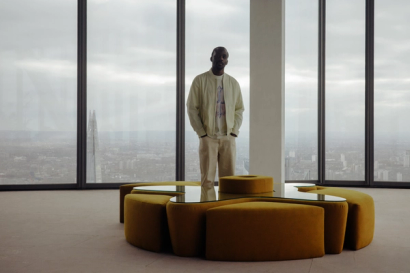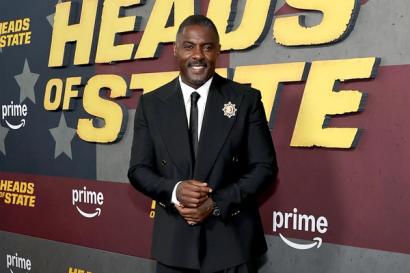
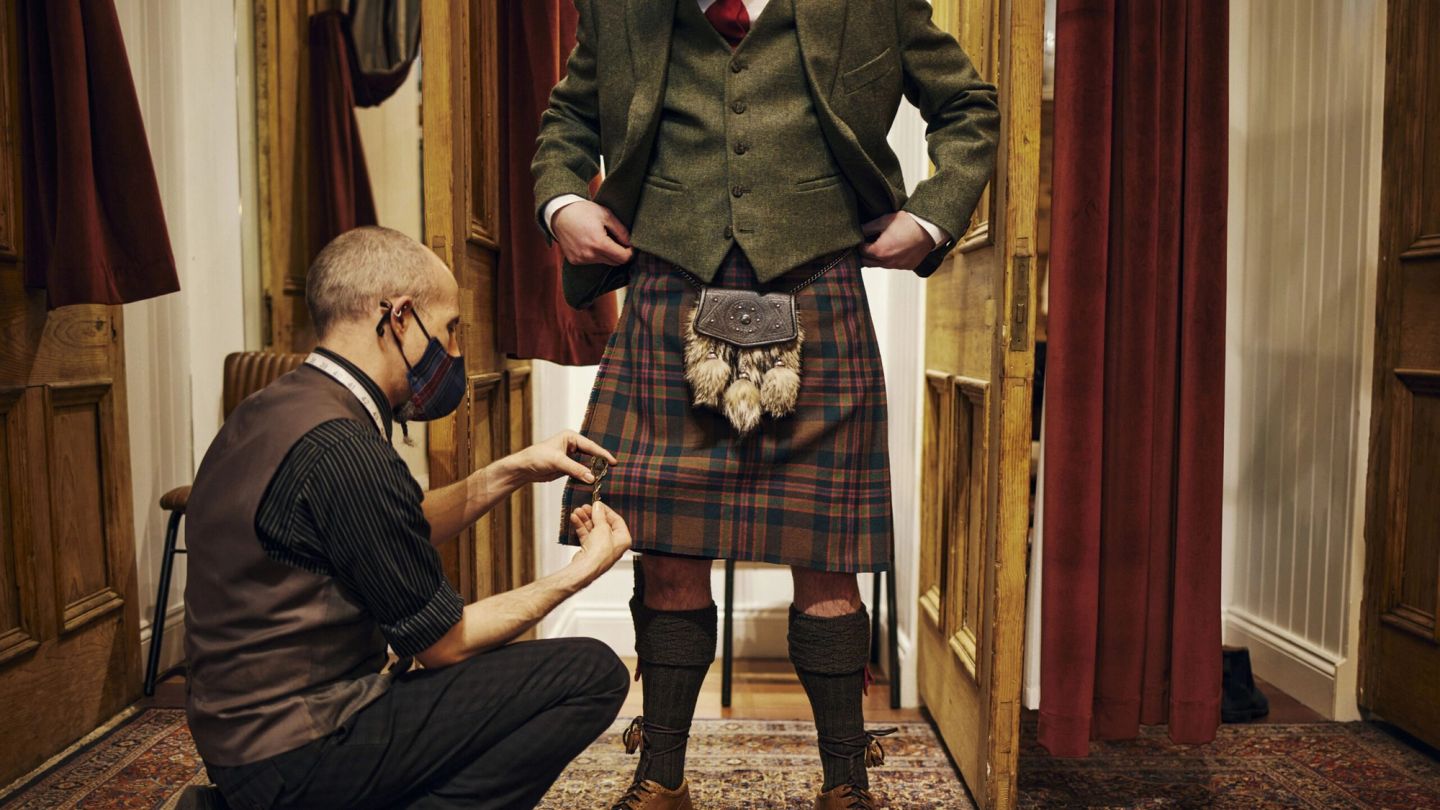
Scotland’s Savile Row: Inside the kilt-tailoring townhouses of Edinburgh
To discover more about the craft of heritage Highlandwear, Gentleman’s Journal travels to the Scottish capital for a peek behind the tartan curtain…
Words: Jonathan Wells
Photography: Greg Funnell
You can hear bagpipes through the wall — or so they tell me. But not today. Today, Gordon Nicolson Kiltmakers is quiet; not a skirl to be heard from the piper’s workshop next door. Instead, there’s a faint murmur of laughter coming from the kiltmaking students upstairs, and the gentle thrum of traffic as it rumbles over Edinburgh’s cobbles outside.
I’m here, like the students, to learn about kilts. I want to know my sporrans from my sgian-dubhs; to tell a MacPherson tartan from a MacFarlane check. Because kiltmaking, a once-dying art, is back on the rise. Artisans across this wild and windy nation are pulling their socks up, securing them with kilt flashes and passionately championing the Highlandwear cause. And here, in the country’s capital, they’re leading the charge.
Twenty years ago, the kiltmaking industry was in trouble. The iconic garment spent years teetering on the cusp of novelty, and it’s only in the last decade that attitudes have changed. Gordon Nicolson, who founded this shop in 2009, refuses to take sole credit for this resurgence in popularity — but perhaps he shouldn’t be so modest. Because, with his bristly beard and an eye for quality craftsmanship, Nicolson is undoubtedly the captain of this kiltmaking ship — and his vision and values have steered an entire industry back on course.
“I’ve also seen our customers change a lot,” Nicolson nods, admitting that a new type of clientele has spurred sales in recent years. “It’s coming down in age — and the background of our customers is also changing. That said, there’s still a range; from the very affluent, to people who have really saved up to buy this kind of thing”.
Nicolson has worked in Highlandwear for decades. Before starting his eponymous brand, the craftsman was employed by McCalls Kilt Hire, and it was while working there he first noticed younger customers taking an interest. Since then, an increasing number of men have started to engage with the tradition — viewing the off-kilter kilt and the sheer number of tartans on offer (over 3,4000 on the official Tartan Register, at last count) as a fresh, exciting way to express themselves. An uptick in pop culture popularity hasn’t hurt either, Nicolson adds.
“My wife is absolutely jumping,” laughs the kiltmaker, “because season six of Outlander is coming in March. I’m old enough to have seen a similar craze 25 years ago, with Braveheart. When that film came out, it sparked something; changed the perception of people who wore kilts. This has been the same. There has certainly been an ‘Outlander effect’.”
Today, in Nicolson’s recently-refurbished store, historic maps hang on the walls — and antique accessories sit pretty in glass cases. You’d be forgiven for thinking that this strong kiltmaking tradition, and the tailors and craftsmen who make them, have been around for generations. And yet, despite the strong, storied history of Highlandwear, kilts have always suffered a chequered commercial past. You won’t, for example, find the same sort of age-old, dynastic tailoring houses here in Edinburgh as you might on London’s Savile Row. And that, Nicolson says, is because the industry has often prioritised profit over quality, and faced peaks and troughs due to a lack of standardisation.
A brief bit of history: The first kilts were worn by Highlanders, with initial examples dating back to the 16th century. Next up, the nobility adopted the look, before it became a uniform for supporters of the Jacobite rebellion. After kilts were outlawed in 1746 (an attempt to stifle yet another uprising against the skittish Hanoverians) the garment took its biggest hit. But, when Sir Walter Scott began writing about them decades later, and King George IV even slipped one on for a trip to Scotland in 1822, the kilt returned to favour. Ever since, the garment’s popularity has waxed and waned — with wavering interest and shifts in demand plaguing kiltmakers, and making it difficult for heritage brands to emerge.
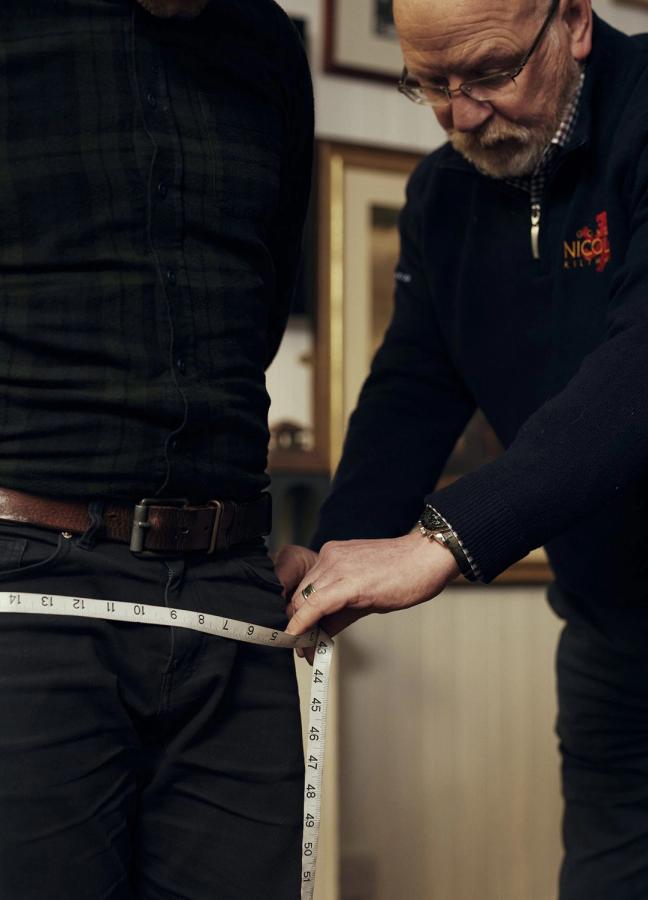
But Gordon Nicolson hopes to buck this tartan trend. “People are finally realising that you don’t have to be a peely-wally, overweight, ginger Scotsman to wear a kilt,” he says. “We know that’s the stereotype — but we need to get rid of that.
“That’s why the way we make our kilts,” he explains, “suits the shape of people today. And it’s a new shape; a body type of people who work out, go to the gym and have big thighs and narrow waists. Because that’s not the shape men used to be. If you tried to make a kilt for that body shape 20 years ago, it would be almost impossible. But now, we’ve worked hard to get that fit in our kilts — to keep the heritage, but to also make sure they look right. We’re not doing anything outside-the-box. We’re just doing things properly.”
"You don’t have to be a peely-wally, overweight, ginger Scotsman to wear a kilt..."
So how do you make a kilt? On the cosy mezzanine level of Gordon Nicolson’s shop, the Edinburgh Kiltmaking Academy is the place to learn. Established by Nicolson in 2016, the institution teaches budding artisans this specialist, patriotic craft — in a similar way to the bagpipe shop next door, which is actively looking for apprentices. (Coincidentally, Nicolson recently bought the bagpipe shop when it was threatened with closure. “I just couldn’t let it go,” he shrugs.)
Today, amidst the reams of tartan and plenty of well-stabbed pin cushions, tutor Kirsty Kinner is teaching the latest kiltmaking cohort how to create a proper, hand-sewn piece of classic Scottish clothing. And I’m listening in.
First up come the measurements. Unlike a tailored suit — which requires at least ten measurements — a bespoke kilt demands only three; your waist, your seat and the length from navel to kneecap. And each kilt, regardless of how slim or slender you may be, is constructed using between eight and nine yards of tartan: delicately pressed and pleated, then sewed and steamed into shape.
“Through the Academy,” says Nicolson, “we’ve raised the standard of kiltmaking. And it’s really quite funny, because we’ve had kiltmakers here from our competitors in the past. There are three here at the moment. But we accept that. If we want to standardise kiltmaking, and shout about our heritage and tradition, that’s what we have to do”.
Of course, all of this investment does come at a price. And, like a trimly-tailored suit, kilts don’t come cheap. A traditional, hand-sewn Scottish kilt will cost you around £525 from Gordon Nicolson, and it’s a similar price elsewhere in Edinburgh. And, while the kiltmaker says he’ll never charge raise prices to unrealistic levels — “We never want to price out the locals,” Nicolson says — he maintains that they’ll never waver on quality. And, if that means a slightly higher cost, then so be it.
This unswerving commitment to quality is something many Edinburgh-based kiltmakers have in common. And, from Geoffrey Tailor to Victor Scott, the city’s High Street is something of a Scottish Savile Row, with kilt boutiques, kilt hire shops and bespoke kiltmakers all sitting along the stretch. Not all create kilts of the same standard, however, as Highland dress manager John Webster explains.
“It all comes down to cost and time,” says Webster, holding court at 63 High St in a bold blue kilt. “And, ten or fifteen years ago, every proper kilt shop was only offering hand-sewn kilts. But then, and I don’t know who first started doing it, somebody began to use machine-stitching, and almost everybody else jumped on the bandwagon. Because it’s less time-consuming, and therefore it’s less expensive — even if it isn’t as special.
“But, if I’m honest,” Webster adds, “I’d rather see somebody in a machine-sewn kilt than not see them in a kilt at all. Do you know what I mean?”
Webster works for John Morrison Kiltmakers, a brand that has been around for 25 years, resurrected the name of a heritage kiltmaker and offers both hand-sewn and machine-sewn kilts. In the company’s workroom — mere minutes up the cobbles — the shelves are divided in two, with hand-drawn labels telling the seamstresses, Donna and Helen, which kilts can be machine-stitched, and which they must sew using their decades of needle-threading, hand-stitching experience.
“But they’re still the same quality,” says Webster of the machine-sewn kilts. “They’re planned in the same way, they’ve got the same linings, the same straps and buckles. We still measure people in the same way, and tailor the kilts. Most people wouldn’t be able to tell the difference, to look at them. But a hand-stitched kilt is a piece of artisan clothing. If people have the money, they won’t think twice — they’ll go for hand-sewn, because that’s how it should be.”
But Webster also acknowledges that the modern kilt industry needs to pique people’s interest before it sells to them; informing would-be buyers about the importance and history of Highlandwear. And, as he reiterates, he’d prefer to see someone pull on a less-expensive, machine-sewn kilt than not wear a kilt at all.
“And somebody who’s spending £35 on a kilt is never, in a million years, going to come in here and spend £600 on a kilt with me,” the Scotsman reasons. “They are two completely different customers. It’s not like-for-like. Someone who buys a second-hand Fiat 500 is never going to go into a Rolls-Royce dealership for a car.
“I will say,” he adds, “that there is a problem with the word ‘kilt’. Maybe we shouldn’t be calling a mass-made, machine-sewn kilt from overseas a kilt. You know how you get these geographical indicators? Maybe there should be a way that the government protects the kilt. Maybe a kilt has to be eight-yards, it has to be hand-sewn, it has to be made in Scotland. And then we call these other things something else, so people aren’t misled.
“I’d rather see somebody in a machine-sewn kilt than not see them in a kilt at all…”
“But somebody could buy a £35 kilt and love it. And then, maybe at some point down the line, they’ll eventually come in here and buy a kilt from me. And they wouldn’t have done that if it wasn’t for that first kilt; that gateway kilt.”
The focus on education, Webster says, is key. Across Edinburgh, every kiltmaker seems keen to teach would-be kilt-wearers about the heritage and charm woven into the fabric of these tartan togs. Emma Wilkinson, a graduate of the Edinburgh Kiltmaking Academy, is now employed as a tutor, and gives educational talks across Scotland for Gordon Nicolson. But, like Webster, Wilkinson sees non-Scottish kilts as a potential problem for the industry.
“Kilts don’t have to be made in Scotland,” Wilkinson explains. “Because it just isn’t bound by law like that. Maybe, one day, it will be. But, right now, kilts can be made anywhere. For us and our customers, however, our kilts are always made in Scotland — and not only here in Edinburgh, but also in Inverness and as far away as Benbecula, a tiny island in the Outer Hebrides.”
The Academy — where the students are still all earnestly stitching away on the mezzanine — has played a great part in exporting consistent, quality talent to every corner of Scotland. Wilkinson says that this was Nicolson’s chief aim when he set up the school five years ago. “He wanted to begin the journey of standardising the industry,” she says, “to set a bar, and give everyone a bar they had to hit to call a kilt a kilt”.
Wilkinson is one of the new generation of kiltmakers, and part of her role at Gordon Nicolson Kiltmakers is to run the brand’s website and social media channels. It’s a challenging task, but Wilkinson says she’s seeing more and more young people engage with the idea of Highlandwear — not to mention more young men looking for an excuse to wear their kilts outside of ceremonial occasions.
“In the highlands, it used to be the everyman’s everyday wear,” she explains. “And we seem to be moving back to that — slowly. Whereas a kilt used to be bought just for a birthday or a wedding, and then put in the cupboard until another wedding or graduation, nowadays guys want to wear them to the rugby, to the football. There are hotels and restaurants across the country that have kilts as their staff’s uniform, because they’re such crowd-pleasers.
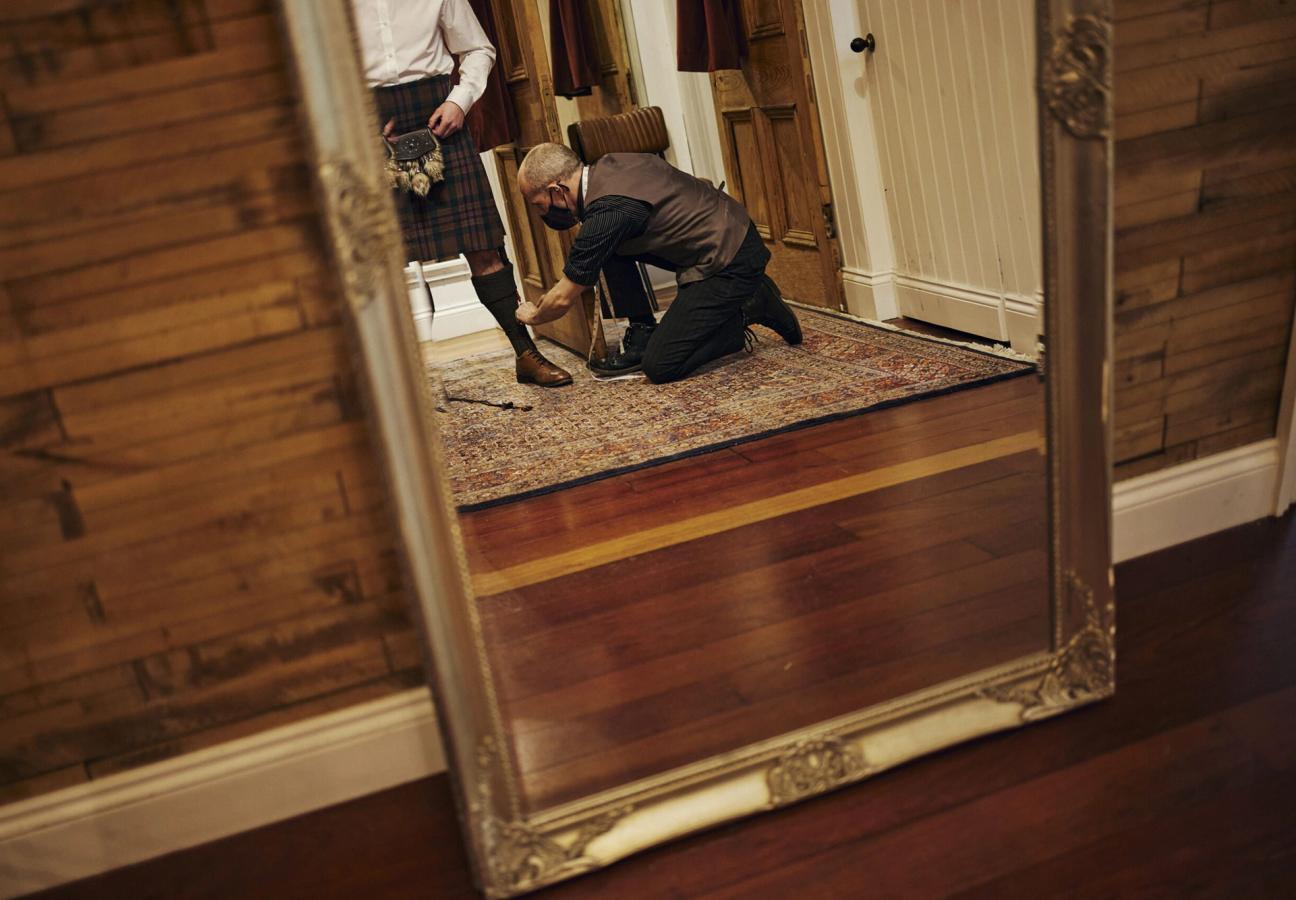
“It really is changing,” the kiltmaker continues. “I’m not sure we’ll see kilts replacing jeans anytime soon — but there’s definitely a shift to find more opportunities to wear them. I want to seem them everywhere. I want to see people photocopying in offices wearing kilts. I want to see people in Tesco pushing their shopping trolleys in kilts.”
Unfortunately, for now, it looks like Wilkinson will have to wait. Because, while the industry may be enjoying another Outlander-fuelled resurgence, kilts are still a way off returning to mainstream menswear. Although, Wilkinson reveals, aside from the wedding season spike, the return of tourism post-pandemic is the biggest boon to Scotland’s Savile Row.
“Even if the tourists don’t have a Scottish connection!” laughs Wilkinson. ”People just love to love kilts — and they’ll just pick a contemporary tartan for their kilt, or a tartan they like the look of. And then, they’ll always ask us: Is this okay? Is this cultural appropriation? And we’ll always say no. If you wear a kilt, you’re celebrating the heritage along with us — that’s the way we see it.”
Want more Scottish spirit? Here are 10 of the tastiest little-known scotch whiskies…
Become a Gentleman’s Journal member. Find out more here.
